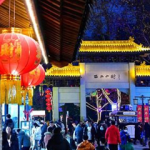
Recently, the Henan Archaeological New Discovery Forum was held in Zhengzhou, and Liu Tao, the leader of the archaeological team of Luoyang Han and Wei City of the Institute of Archaeology of the Chinese Academy of Social Sciences, introduced the latest excavation results of the palace site of Luoyang City of the Han and Wei Dynasties.
The ruins of the palace city of Luoyang City in the Han and Wei dynasties were the capital of the Eastern Han Dynasty, Cao Wei, Western Jin Dynasty and Northern Wei Dynasty. In 2023, the Institute of Archaeology of the Chinese Academy of Social Sciences excavated the east wall, the southeast corner of the palace, and the northwest corner of the warehouse cellar area of Luoyang City in the Han and Wei dynasties.
Liu Tao introduced that the newly discovered east wall and south wall of the North Palace of the Eastern Han Dynasty were cleverly built on the inside of the gully at the edge of the platform by making clever use of the topography and geomorphological characteristics of the platform. The scope of the Northern Palace of the Eastern Han Dynasty is roughly the same as that of the palace in the Wei, Jin, and Northern Wei dynasties, but the location of the walls in different areas has changed slightly. From the Eastern Han Dynasty to the Northern Wei Dynasty, there were roads of different widths and different periods, and the roads in the Northern Wei Dynasty were the widest. The palace city of the Northern Wei Dynasty was built and used on the basis of the Northern Palace of the Eastern Han Dynasty and the Luoyang Palace of the Sixteen Kingdoms of the Wei and Jin Dynasties.
This discovery pushed the founding age of the palace city of Luoyang City in the Han and Wei dynasties from the Wei and Jin dynasties to the Eastern Han Dynasty, and enriched the historical and cultural connotation of Luoyang City in the Han and Wei dynasties. The fact that the North Palace of the Eastern Han Dynasty was built according to the natural landform intuitively reflects the construction ideas of Luoyang City in the Han and Wei dynasties, as well as the new height reached by the ancients in their understanding and utilization of natural conditions. In the excavation of the warehouse cellar area, archaeologists found more than 200 pieces of pottery money on the east side of the palace wall of the Northern Wei Dynasty, on which the recognizable money inscription has the words “Daquan Fifty”, which is the first time that a clear relic of the Xinmang period has been found in the ruins of Luoyang City in the Han and Wei dynasties. (Luoyang Daily Financial Media Luoyang Net Reporter Wisdom Picture for archaeological data)








